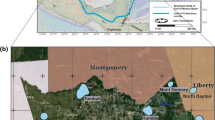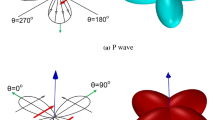Abstract
The increased emission of greenhouse gases into the atmosphere, causing climate changes, leads to a strong requirement of renewable energy resources. However, they are intermittent and need buffer storage to bridge the time gap between production and public demands. The injection of gas (e.g. compressed air or hydrogen) in sealed underground structures like salt caverns is one approach to solve this problem. Possible risks related to cavern storage are gas leakages from the injection tube into the surrounding sediments, material failure in salt rock surrounding the cavern during irregular operation and in the most extreme case a partial collapse of the cavern. For the early detection of these problems, a geophysical monitoring strategy is required. The objective of this paper was to map possible leakage paths outside of the salt structures and local failures within the cavern walls by the localization of crack-induced microseismic events. Classical methods require arrival time picking and phase identification. An alternative approach is elastic reverse-time modelling (RTMOD), where the recorded microseismic events are numerically backpropagated from the receiver positions into the elastic underground model. The resulting seismic wavefield focuses at the location of the event, which can be subsequently imaged by estimating the maximum of the seismic energy at each underground point. However, the success of this approach highly depends on the used elastic background model. In case of complex salt bodies, the strong velocity contrast between the salt and the surrounding sediments is a major problem. Therefore, we propose a combined monitoring approach, consisting of a seismic full waveform inversion of active source reflection seismic data to accurately image the background velocity model and subsequent RTMOD for the microseismic event localization. Accuracy and sensitivity with respect to the acquisition geometry and random noise will be demonstrated using a complex benchmark model. Furthermore, the localization accuracy is discussed for three different scenarios covering the detection of a partial cavern collapse, a gas leakage and the occurrence of cracks within the cavern wall due to extreme loading conditions during irregular operation.












Similar content being viewed by others
References
Aki K, Richards P (1980) Quantitative seismology. W.H. Freeman and Company, Bedford
Artman B, Podladtchikov I, Witten B (2010) Source location using time-reverse imaging. Geophys Prospect 58(5):861–873
Bauer S, Beyer C, Dethlefsen F, Dietrich P, Duttmann R, Ebert M, Feeser V, Görke U, Köber R, Kolditz O, Rabbel W, Schanz T, Schäfer D, Würdemann H, Dahmke A (2013) Impacts of the use of the geological subsurface for energy storage: an investigation concept. Environ Earth Sci 70(8):3935–3943
Ben-Menahem A, Singh S (1981) Seismic waves and sources. Springer, Heidelberg
Billette F, Brandsberg-Dahl S (2005) The 2004 BP velocity benchmark. In: 67th Annual international meeting, EAGE, expanded abstracts, EAGE, p B035, benchmark model. http://software.seg.org/datasets/2D/2004_BP_Vel_Benchmark/
Bohlen T (2002) Parallel 3-D viscoelastic finite-difference seismic modelling. Comput Geosci 28(8):887–899
Brossier R (2011) Two-dimensional frequency-domain visco-elastic full waveform inversion: parallel algorithms, optimization and performance. Comput Geosci 37(4):444–455
Cha Y, Shin C (2010) Two-dimensional Laplace-domain waveform inversion using adaptive meshes: an experience of the 2004 BP velocity-analysis benchmark data set. Geophys J Int 182(2):865–879
Evans D (2007) An appraisal of underground gas storage technologies and incidents, for the development of risk assessment methodology. Open Report OR/07/023, British Geological Survey, i: 264 p, II: 58 p
Gajewski D, Sommer K, Vanelle C, Patzig R (2009) Influence of models on seismic-event localization. Geophysics 74(5):WB55–WB61
Gajewski D, Kashtan B, Tessmer E, Vanelle C (2008) Localization of acoustic emissions by back-projection: inherent localization and timing errors. In: 9th Annunal report of the wave inversion technology consortium, pp 127–132
Gajewski D, Tessmer E (2005) Reverse modelling for seismic event characterization. Geophys J Int 163(1):276–284
Gaßner L (2014) 3D Finite-differenzen modellierung von mikroseismischen Ereignissen im Bereich Landau in der Pfalz. Master thesis, Karlsruhe Institute of Technology. http://nbn-resolving.org/urn:nbn:de:swb:90-441502
Groos L (2013) 2D full waveform inversion of shallow seismic Rayleigh waves. Ph.D. thesis, Karlsruhe Institute of Technology. http://nbn-resolving.de/urn:nbn:de:swb:90-373206
Hesthaven J, Warburton T (2008) Nodal discontinuous Galerkin methods: algorithms, analysis, and applications. Springer, New York
Khaledi K, Mahmoudi E, Datcheva M, Schanz T (2016) Stability and serviceability of underground energy storage caverns in rock salt subjected to mechanical cyclic loading. Int J Rock Mech Min Sci 86:115–131
Khaledi K, Mahmoudi E, Datcheva M, Schanz T (2014) Finite element modeling of the behavior of salt caverns under cyclic loading. In: Geomechanics from Micro to Macro. Informa Limited, UK, pp 945–950. doi:10.1201/b17395-169
Köhn D, De Nil D, Kurzmann A, Przebindowska A, Bohlen T (2012) On the influence of model parametrization in elastic full waveform tomography. Geophys J Int 191(1):325–345
Köhn D, Kurzmann A, De Nil D, Groos L (2014) DENISE–user manual. http://www.geophysik.uni-kiel.de/%7Edkoehn/software.htm
Komatitsch D, Martin R (2007) An unsplit convolutional perfectly matched layer improved at grazing incidence for the seismic wave equation. Geophysics 72(5):155–167
Levander A (1988) Fourth-order finite-difference P-SV seismograms. Geophysics 53(11):1425–1436
Li Z, van der Baan M (2016) Microseismic event localization by acoustic time reversal extrapolation. Geophysics 81(3):KS123–KS134
Luo X, Wang J, Dooner M, Clarke J, Krupke C (2014) Overview of current development in compressed air energy storage technology. Energy Proc 62:603–611
Métivier L, Bretaudeau F, Brossier R, Operto S, Virieux J (2014) Full waveform inversion and the truncated Newton method: quantitative imaging of complex subsurface structures. Geophys Prospect 62(6):1353–1375
Mora P (1987) Nonlinear two-dimensional elastic inversion of multioffset seismic data. Geophysics 52:1211–1228
Nakata N, Beroza G (2016) Reverse time migration for microseismic sources using the geometric mean as an imaging condition. Geophysics 81(2):KS51–KS60
Nocedal J, Wright S (2006) Numerical optimization. Springer, New York
Plessix RE (2006) A review of the adjoint-state method for computing the gradient of a functional with geophysical applications. Geophys J Int 167(2):495–503
Plessix RE, Mulder WA (2004) Frequency-domain finite-difference amplitude-preserving migration. Geophys J Int 157(3):975–987
Reitze A, Hasselkus F, Wurmbauer P (2014) Today’s technology for monitoring caverns. BHM Berg- und Hüttenmännische Monatshefte 159(4):149–153
Robertsson JOA (1996) A numerical free-surface condition for elastic/viscoelastic finite-difference modeling in the presence of topography. Geophysics 61:1921–1934
Schweitzer J, Fyen J, Mykkeltveit S, Kværna T (2009) Seismic arrays. In: Bormann P (ed) New Manual of Seismological Observatory Practice (NMSOP), Deutsches GeoForschungsZentrum GFZ, Potsdam, chap 9, pp 1–52. http://bib.telegrafenberg.de/publizieren/vertrieb/nmsop/#c1387
Shapiro S (2015) Fluid-induced seismicity, 1st edn. Cambridge University Press, Cambridge
Shin C, Yoon K, Marfurt K, Park K, Yang D, Lim H, Chung S, Shin S (2001) Efficient calculation of a partial-derivative wavefield using reciprocity for seismic imaging and inversion. Geophysics 6:1856–1863
Shipp R, Singh S (2002) Two-dimensional full wavefield inversion of wide-aperture marine seismic streamer data. Geophys J Int 151:325–344
Steiner B, Saenger EH, Schmalholz SM (2008) Time reverse modeling of low-frequency microtremors: application to hydrocarbon reservoir localization. Geophys Res Lett. doi:10.1029/2007GL032097
Tarantola A (2005) Inverse problem theory. SIAM, Philadelphia
Virieux J (1986) P-SV wave propagation in heterogeneous media: velocity–stress finite-difference method. Geophysics 51(4):889–901
Wang T, Yan X, Yang H, Yang X, Jiang T, Zhao S (2013) A new shape design method of salt cavern used as underground gas storage. Appl Energy 104:50–61
Acknowledgments
This study has been carried out within the framework of the ANGUS+ research project (Bauer et al. 2013) funded by the German Federal Ministry of Education and Research (BMBF) and the MeProRisk-II Project funded by the German Federal Ministry for the Environment, Nature Conservation, Building and Nuclear Safety (BMU). The FWI inversions were performed on the NEC-HPC Linux-Cluster at Kiel University. The Open Source 2D PSV–FWI and reverse-time modelling code DENISE Black-Edition is available under the terms of GNU GPL 2.0 at https://github.com/daniel-koehn.
Author information
Authors and Affiliations
Corresponding author
Additional information
This article is part of a Topical Collection in Environmental Earth Sciences on “Subsurface Energy Storage”, guest edited by Sebastian Bauer, Andreas Dahmke, and Olaf Kolditz.
Rights and permissions
About this article
Cite this article
Köhn, D., De Nil, D., al Hagrey, S.A. et al. A combination of waveform inversion and reverse-time modelling for microseismic event characterization in complex salt structures. Environ Earth Sci 75, 1235 (2016). https://doi.org/10.1007/s12665-016-6032-4
Received:
Accepted:
Published:
DOI: https://doi.org/10.1007/s12665-016-6032-4




